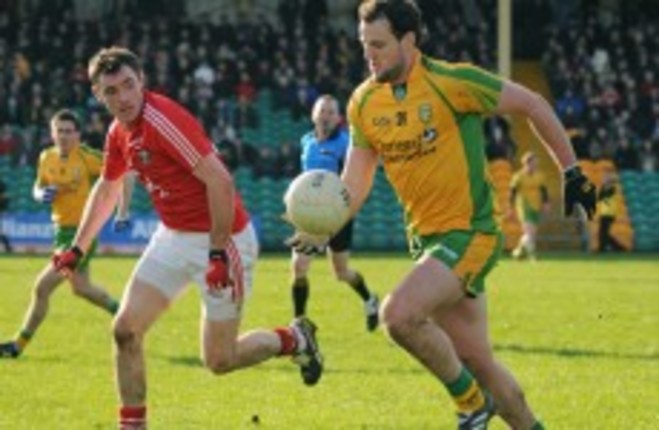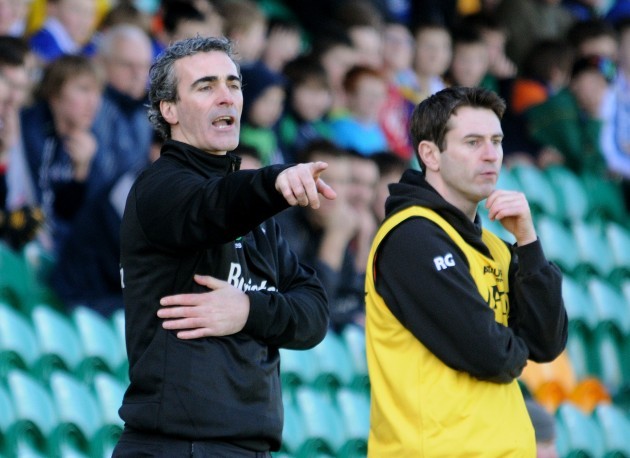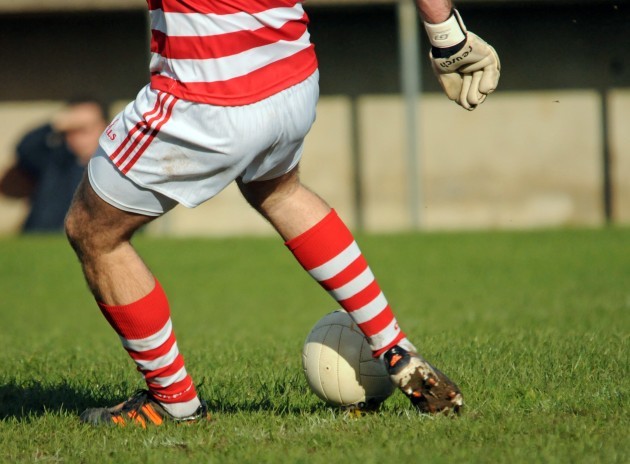Reproduced with permission from Action81
DONEGAL RECORDED THEIR first victory of the 2012 league campaign, and indeed in any competition this year, with an impressive home display. Emmet Ryan breaks down a fascinating tactical battle.
Donegal start brightly
The questions over the decision to start Michael Murphy appeared to be answered within seconds of throw-in. Murphy, who was well below full fitness, found the net after Karl Lacey passed to him inside.
The first 10 minutes looked familiar to anyone who watched Donegal in 2011. The home side was patient in their build-up play and there was a focus on getting back to cover in waves rather than immediately seeking to engage in one-on-one tackling.
The emphasis was on control and all appeared to be going to plan early on. Murphy was dropping back on kick-outs, encouraging a short ball which forced Cork to build slowly from deep. The Rebels, more comfortable with fast breaks, had trouble creating chances early as Barry O’Driscoll and Mark Collins were both bottled up early by a horde of green and gold jerseys. Chances however weren’t coming at the other end.
Cork shut down Route 26
Despite his initial burst, Murphy’s presence in the front-line became more questionable as the first half wore on. The big man, who was wearing number 26 in lieu of his usual 14, proved an all too obvious target for Donegal’s attacks. Cork regularly doubled up on Murphy and dropped their backs deeper so as to burst out and disrupt the home side’s play. The tactic nullified Donegal’s attack entirely for 27 minutes.
Although the visitors initially looked uncomfortable engaging in a territorial war, it was Cork who undoubtedly won that battle in the opening 35 minutes. When chances to strike quickly were available, Cork proved eager to take them. Aidan Walsh recorded their opening score on 13 minutes and Graham Canty cut inside well to create a quality chance a minute later but his effort went wide. Cork eventually clawed level before Murphy gave Donegal a slender lead at the interval. The momentum looked to be on Cork’s side and it would swing heavily towards them at the resumption of play.
Rebels press the middle
No team is as purely built for swarm-busting as Cork. Even short a couple of likely starters, the Rebels had an abundance of players built to work the middle and target the spine of any swarm. Their wins over Tyrone in 2009, Dublin in 2010, and again over Dublin in the 2011 league final, were all achieved by hammering the middle. It was those wins that led to me selecting this pairing as the tactical battle with the most potential in 2012.
In the second half we finally got to see the two strategies go up against one another head-on. For the first five minutes the Rebels were on course for a brutal knock-out victory. In that spell scores from Colm O’Neill and Patrick Kelly gave the visitors their first lead of the day. Attacking pressure began in the half backs as the Rebels targeted the middle to tear open a Donegal defence that was already looking shaky. The front line forwards meanwhile took on more defensive duties, forcing backs to hurry clearances and mistime passes.
Though the lead was just a point, in that brief spell, Cork’s route one power looked unstoppable.
Murphy proves his value
Then Donegal made the switch that won the game. Murphy, having effectively run out of gas as a pure front-man, dropped deep. Moving Murphy back to just in front of midfield changed every aspect of the game.
Donegal manager Jim McGuinness with his assistant Rory Gallagher on the line yesterday. Pic: INPHO/Kieran Murray
Having been crowded out up front, Murphy now had space and time to operate, turning him into more of a creator in attack. His link up play with Colm McFadden immediately took a turn for the better. A deep ball from Murphy to McFadden on 52 minutes put the latter through on goal only for Ken O’Halloran to save. A second long ball link-up between the pair would result in a McFadden point on 57 minutes. Murphy was also at the helm on 64 minutes orchestrating a three man move that saw Rory Kavanagh set-up Martin O’Reilly for a point.
Murphy’s re-deployment brought the shape back to Donegal’s defence. The Cork half backs were now stifled in their attempts to charge up the middle, with their moves largely being stopped at midfield. The deeper role also enabled Murphy to drop back more in defensive cover. With his extra size inside, Karl Lacey’s positional nous came to the fore and the home side comfortably forced Cork wide whenever they moved upfield. Even a late charge for goal from the Rebels phased the defence as they easily pressed the move wide before winning a free-out.
The biggest criticism of Donegal in 2011 was the use of an attacking threat like Murphy in such a defensive role. The explosive nature of his forward play makes it easy to see why. His roles as a creator and a defender are just as irreplaceable but far less obvious to the casual viewer. Today this switch led to one of the most dominant individual displays this column has ever covered.
When Murphy is a pure 14 he is a guaranteed mis-match and likely to post a sizeable tally. When he plays deeper however he enables all of Donegal’s other parts to flourish and that’s a more complex problem for opponents to counter.
The verdict
The key tactical battle took a while to unfold but once it did there was a clear winner. Donegal, bolstered by Murphy’s deeper role, found their composure and stunted Cork’s efforts to break through their defence. For all the benefit of Murphy’s switch, without his major at the start of the game the score at half time could have been very different. What to do with Murphy, short of cloning, is difficult to answer.
He effectively needs to be all things to Donegal. Without him up front Donegal lose their best scoring threat, with him there his absence is felt in every other area of the park. For now mixing his roles remains the only option really available to Jim McGuinness. Murphy has certainly shown he has the fitness to cope with a heavy workload. There are however positive signs that Donegal won’t need to lean on him as a pure scorer to the same extent going forward.
Cork goalkeeper Ken O’Halloran take a goal kick Pic: INPHO/Kieran Murray
Critically the improvement of McFadden and Patrick McBrearty’s partnership as the game wore on showed Donegal have potential alternatives up front. The duo looked static when Murphy first dropped back and each tried to adopt the same role target man role. Once McBrearty started playing off centre more, the partnership looked far more dangerous.
Defensively Karl Lacey’s positioning remains a crucial asset while Paul Durkan’s ability to disguise his kick outs is a useful weapon in creating attacks. On the whole Jim McGuinness can view this as a big step after a rocky start to 2012.
Cork’s strength remains in the half back line but, even accounting for absences, their lack of a Plan B once that supply line was choked disappointed. Having asked hard questions of their hosts with defensive adjustments in the first half, the Rebels could not find another way to create chances when their chief asset was restricted. Cork’s fundamentals are sound but this unit has to prove more capable of adapting its game.
Follow Emmet Ryan on Twitter.



